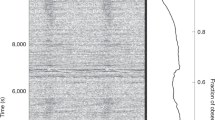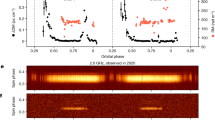Abstract
Boriakoff et al.1 have reported the discovery of a 6.1-ms radio pulsar in a binary with an orbital period of 120 days, a1 sin i = 0.99 × 1012 cm, and e ≈ 0. This is the fourth binary radio pulsar, and the third to have a nearly circular orbit2. The origin of such systems has been discussed frequently3,4 and I now report that evolutionary history of the new millisecond pulsar is perhaps the simplest of them all. The rapid rotation of the pulsar, small mass function, circular orbit, and long binary period suggest that following the formation of a neutron star there had to be a phase of mass transfer from the low-mass secondary onto the neutron star primary. That mass transfer circularized the orbit and spun up the primary, and it required the secondary to be a red giant at that time. The present binary period of 120 days implies that the secondary has a mass of 0.3 M⊙. The observed mass function of 0.0027M⊙ implies that the primary must be less massive than 3.1M⊙, not an interesting mass limit for a neutron star. The secondary is probably a white dwarf at present. However, if the mass transfer terminated < 106 yr ago then the secondary may be still burning hydrogen at the rate of about 300L⊙, and it may be optically detectable.
This is a preview of subscription content, access via your institution
Access options
Subscribe to this journal
Receive 51 print issues and online access
$199.00 per year
only $3.90 per issue
Buy this article
- Purchase on Springer Link
- Instant access to full article PDF
Prices may be subject to local taxes which are calculated during checkout
Similar content being viewed by others
References
Boriakoff, V., Buccheri, R. & Fauci, F. IAU Circ. No. 3806 (1983); Nature 304, 417–419 (1983).
Taylor, J. H. IAU Symp. No. 95, 361–369 (1981).
Blandford, R. D. & DeCampli, W. M. IAU Symp. No. 95, 371–377 (1981).
van den Heuvel, E. P. J. IAU Symp. No. 95, 379–394 (1981).
Webbink, R. F., Rappaport, S. & Savonije, G. J. Astrophys J. (in the press).
Trimble, V. Nature 303, 137–142 (1983).
Paczynski, B. Acta Astr. 31, 1–12 (1981).
Refsdal, S., Roth, M. L. & Weigert, A. Astr. Astrophys. 36, 113–120 (1974).
Refsdal, S. & Weigert, A. Astr. Astrophys. 6, 426–440 (1970).
Author information
Authors and Affiliations
Rights and permissions
About this article
Cite this article
Paczynski, B. Evolutionary history of the 6.1-ms pulsar. Nature 304, 421–422 (1983). https://doi.org/10.1038/304421a0
Received:
Accepted:
Issue Date:
DOI: https://doi.org/10.1038/304421a0
This article is cited by
-
Formation of Double Neutron Stars, Millisecond Pulsars and Double Black Holes
Journal of Astrophysics and Astronomy (2017)
-
Magnetic Fields of Neutron Stars
Journal of Astrophysics and Astronomy (2017)
-
Scenarios for the formation of binary and millisecond pulsars – A critical assessment
Journal of Astrophysics and Astronomy (1995)
Comments
By submitting a comment you agree to abide by our Terms and Community Guidelines. If you find something abusive or that does not comply with our terms or guidelines please flag it as inappropriate.



